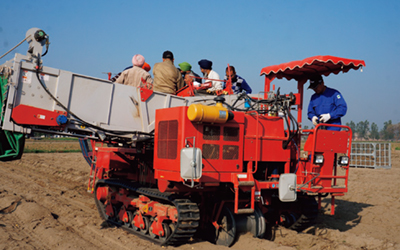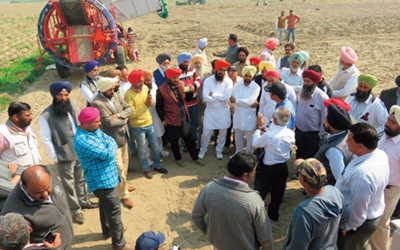Master Techniques from Japan to the World 2
Japanese Technology Changes Potato Cultivation in India
– Aiming for Mechanized Harvesting Through Improved Cultivation Methods
Few realize that India is the second largest producer of potatoes in the world by volume. The majority of potatoes produced in the country are consumed domestically, and the consumption of processed foods such as potato chips and French fries has been increasing in recent years.
Meanwhile, a major problem is emerging. In India, the majority of farmers operate small scale farms, and the entire process from tilling ridges and planting the seed potatoes to harvesting is done by hand, requiring many workers. However, in recent years it is said that especially small scale farmers even quit potato production due to worker shortage from rising labor cost and the trend of workers to seek out jobs in the cities, which are pushed up by the development of the Indian economy. Given these conditions, there is an urgent need to mechanize farming so as not to depend on many hands.

Local farmers listen how to operate a potato harvest machine as they ride it.(Photo: Toyo Agricultural Machinery Manufacturing Co., Ltd.)
Aiming to mechanize potato production and establish an efficient production system in India, Toyo Agricultural Machinery Manufacturing Co., Ltd. (headquartered in Obihiro City, Hokkaido), a top manufacturer which accounts for roughly 70% of Japan's domestic potato harvest machines market, took a Project Feasibility Survey using ODA to spread potato harvest machines to be used in India from 2014, including market research and performance tests of harvest machines, as well as demonstrations to farmers. Working with the Horticulture Department, Government of the Punjab State as their counterpart, an organization which accounts for 85% of seed potato production in India, a project under the ODA scheme, “A Verification Survey with the Private Sector for Disseminating Japanese Technologies for Potato Harvesters” was started in 2015.
Mr. Toshinobu Ohashi, Managing Director at Toyo Agricultural Machinery who frequently visited India and gave Indian people guidance on the project, harked back to the initial situation of the project as follows:
“We are a manufacturer of potato harvest machines, so originally we came to do a survey on improving efficiency by mechanizing the harvesting process. However, after going to see many farmers, we realized that their cultivation methods were quite diverse, and there were many cases where mechanization could not be applied. But I felt that their lack of technical knowledge in cultivation methods was an even more serious problem.”
In other words, in order to achieve results through mechanization, his company first had to teach them the proper cultivation methods, and since then the contents of instruction guidance has changed considerably.
Looking back on those days, Mr. Ohashi explains, “Luckily our company has also acquired knowledge of cultivation technologies through various projects, so we were able to deploy staff from Japan to provide instruction on everything from field tilling, creating ridges and furrows, planting seed potatoes, to improve potato quality and harvesting.”
The results became clear in the first year with yield increased by 30% and an elimination of the problem of potatoes turning green during growth (by which the toxin solanine becomes present in the potato). This major success brought about a major change in the attitude of Indian farmers.
Mr. Ohashi explains, “When we visited India, conducting the survey for the first time, the farmers were not favorable to us, believing that there was nothing to be taught by Japanese. Furthermore, we did not know whether our guidance was appreciated by them or not, because Indian people tend not to show their emotions too much. But suddenly one day, they started thanking us and telling us that they have learned much from us and that after their own research, they realized that our guidance was correct. They even said that they wanted to do things in the Japanese way, and even wishing to come to Japan for observation, and I was truly happy to hear their words.”

Punjab government officials and local farmers listen to a talk on mechanized harvesting from members of Toyo Agricultural Equipment. (Photo: Toyo Agricultural Machinery Manufacturing Co., Ltd.)
However, despite these successes, there were also things in which the plan had to be changed. While the original intent had been for Toyo Agricultural Machinery to provide the harvest machines required for mechanization, the company realized that it would be difficult for small scale farmers in India to afford the purchase of even a small size harvest machine.
Therefore, Toyo decided to cooperate by providing local technical training in an aim to achieve local production of harvest machines. The current challenge is to find a partner in that effort, and Toyo continues to approach various farm equipment and tractor manufacturers.
“We are providing technical training rather than simply providing equipment, so our relationship with the people in India becomes deeper as we move forward. Potato harvest machines wear out rather quickly because they dig up the potatoes from under the soil. This means that the after-sales service system is extremely important, and there will be no difference in India as well. We wish to provide technical training to a partner who will fully understand this requirement.” says Mr. Ohashi.
If the local production of an Indian-model harvest machine using Japanese technology can be proven, there will be major potential for further business developments for Toyo Agricultural Machinery.
<< Previous Page Next Page >>
Main Text | Statistics and Reference Materials | Stories from the Field | Master Techniques from Japan to the World | ODA Topics
